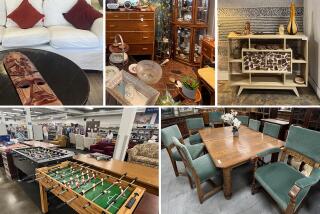FURNISHINGS : Picking the Pieces That Age Well
- Share via
Furniture has been called sculpture that we live with, architecture for the body. Museum pieces or those with a famous architect’s name attached come to mind.
Thomas Chippendale was the designer of note in the 18th Century. In the 19th Century, Michael Thonet’s bentwood Vienna chair was one of the first big successes of mass production, which made well-made furniture widely affordable. Brahms used a Thonet chair at his piano. The same style was popular in Vienna’s cafes. Millions have been sold since.
“It was always inexpensive, like a pair of blue jeans,” says Carl Magnusson, senior vice president of Knoll International in New York. “Today, you can buy the chair in a furniture store for $40.”
But how can today’s shopper pick out the artful from the ordinary? Are classics-in-the-making out there?
“Classics are being created today,” says Jens Risom, a designer and former manufacturer in New Canaan, Conn. “But you have to wait at least 20 years to find out if a design is a classic.”
“There is no reason to believe we’ve come to the end of creativity and progress in furniture,” Magnusson says. “In fact, there is more good furniture than ever before.”
But where?
David McFadden, decorative arts curator at the Cooper Hewitt Museum in New York, looks for interesting new designs in small galleries and crafts fairs and furniture trade shows where the work of new designers is shown.
Clues to quality are readily available and similar for both machine-made and handmade furniture, Risom says. Start with pleasing lines, careful workmanship and working parts that operate smoothly. The piece should not look out of place with furniture from other eras, and it should have continuing appeal, even after years have elapsed.
Risom gives the nod for value to modern, mass-produced pieces because they are sturdy, readily available and generally less expensive than handmade and antique pieces.
“If you set out to make quality furniture by machine, you can do it,” he says. “In fact, there is very little you cannot make on a good machine.”
McFadden says one of the fallacies about old furniture is that it is better.
“One of the most frequently encountered complaints about furniture in every era is that it is shabbily made,” he says. “This was an issue in 18th-Century London, when furniture was mostly handmade, and it remains an issue in 20th-Century America, when most pieces are mass-produced in whole or in large part.”
Today, there is a demand for one-of-a-kind pieces. The argument for the handmade usually centers on technical mastery in construction and embellishment as part of the aesthetic appeal. Joinery and carving, for example, are given added importance.
But the main appeal of modern mass-produced pieces is the quality of the design and, sometimes, use of unusual materials, such as stainless steel.
Magnusson looks for a quality he calls cultural content, or expressiveness, to separate present or future classics from the run-of-the-mill. Expressiveness is often in the details and may hinge on something as minor as the way a leg is attached to a seat.
“Comparing two pieces identical in function and materials,” he says, “one may convey elegance, the other mere utility.”


